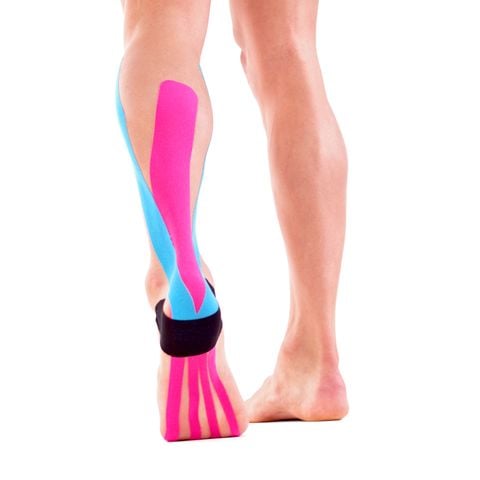Let’s talk about Kinesiology tape for runners.
Seriously, everything you could need to know about K-tape


Kinesiology tape, or K-tape for short, is a stretchy tape developed in the ’70s by Dr Kenzo Kase, a chiropractor who wanted a tape to support soft tissue injuries without limiting the bodies movement, in the way other athletic tapes do (for example, Zinc oxide tape is robust and rigid, perfect for ankle stability taping which is the properties of most other tapes out there – opposite to K-tape).
There is over 50 brands of K-tape on the market today (KT tape and RockTape for example) in all fancy colours and patterns (from bright pinks to tattooed style) and can be worked on every part of the body. From easing swelling to aiding with pregnancy belly discomfort (especially for the pregnant runner) to getting you through races from muscle strains and everything in between.
Now, as a therapist, I understand this does not work for everyone, nor does it work for every rhyme and reason you’re actually applying it for. So, I’ve added pointers to this article both from research, from a runner and as a therapist perspective. If you’re new to Kinesiology tape, was referred to the idea by a friend or fellow runner, whether you’ve had it applied before and not quite sure what it is; the answers are all below.


K-tape is a verrrrry stretchy cotton-nylon-mesh fabric tape (usually latex-free- but check brand to brand if you are allergic) designed with skin in mind.Kinesiology tape’s role is to allow movement of joints, whilst also supporting it – so it needs a stretchy nature (as does your skin).
Not sure what I mean? Do this: Straighten your leg and look at your knee. Usually, there’s looser skin on your knee cap right? Bend your knee and the loose skin is tight – that is how K-tape will also work.
Back to the tape – it’s designed similar to your skin, it is breathable and water-resistant (so it doesn’t just fall off in the shower or rainy runs like other tapes). The glue is heat activated (we will go through this later) and can last for about 3-4 days of workouts and showers due to its strong medical grade adhesive.


K-tape will not solve all of your running woes. But it does do a good job in aiding your rehabilitation post-injury, and alleviating tension-based pain:
Many trainers will use K-tape as part of a treatment plan following injury (myself included) but it cannot work alone and needs other manual treatment to fully benefit (so don’t replace your physical therapist appointment with a roll of tape).
during a musculoskeletal (MSK) injury rehabilitation plan, there is bound to be muscle imbalances – one weaker than the other. To avoid further injury, K-tape can be applied whilst doing your exercises. It will give your muscle that extra little hand it needs to get back on track.
remember that K-tape creates space around a joint? If you have a friction-based injury such as IT band friction syndrome, Achilles tendonitis, patellofemoral stress syndrome, then by specific application of K-tape, space can be created, pain averted and healing can begin (instead of re-injuring it every time you head out to run again).


There are many times K-tape should be avoided, such as:
Whilst so many sports personalities use Kinesiology tape, there is research out there indicating it does nothing more than minimal gains, simply a tool to make you feel better. A ‘mind over matter’ if you will. BUT, as a therapist myself, and an avid long-distance runner, I can attest, it works in conjunction with other therapies like manual therapy and exercises. Whether the science says it or not.
Little back story: In 2016 I ran 10 marathons in 10 days, and boy did it hurt! Predominantly road running from the London Tower to the Eiffel Tower. And yes, I ran into ridiculous pain and injuries, one, in particular, was my quadricep ‘pull’. A light strain on day 4/10 I felt like a zombie, dragging my right leg through for another step. At a stop, my support team applied K tape to give me something, anything to help. And whether it was my mind. Or it was the technology. I don’t care it worked! And I finished that day in a little less pain than I should have.
Now you know exactly when to use it, next we move on to how to apply and removed K-tape. And you’ll be back running PB’s before you know it.





